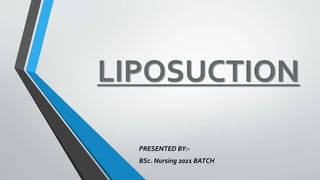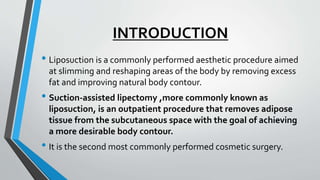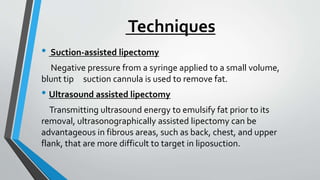lipectomy procedure in burns treatment regimen
- 1. LIPOSUCTION PRESENTED BY:- BSc. Nursing 2021 BATCH
- 2. INTRODUCTION ? Liposuction is a commonly performed aesthetic procedure aimed at slimming and reshaping areas of the body by removing excess fat and improving natural body contour. ? Suction-assisted lipectomy ,more commonly known as liposuction, is an outpatient procedure that removes adipose tissue from the subcutaneous space with the goal of achieving a more desirable body contour. ? It is the second most commonly performed cosmetic surgery.
- 3. DEFINITION Liposuction (lipoplasty) is the elimination of unwanted fat and persistent pockets of fat in the: ? Abdomen ? Hips ? Thighs ? Buttocks ? Arms
- 4. NON-COSMETIC INDICATIONS ? LIPOMAS AND ANGIOLIPOMAS With no and or minimal scarring.
- 5. Lipedema ? In which subcutaneous fat deposition in the lower limbs can affect the daily activities such as walking etc.
- 6. Lymphedema ? Particularly if it is refractory to traditional conservative treatments.
- 7. Cervicodorsal lipodystrophy ? Associated with Cushing syndrome and use of HIV medications.
- 8. Gynecomastia(male) and macromastia(female ) ? In congestion with mammoplasty. Additionally, liposuction can be used to.
- 9. Surgeries ? Reduce excess fat deposits at the surgical sites in obese patient who are undergoing tracheostomy, colostomy , urostomy etc.
- 10. Techniques ? Suction-assisted lipectomy Negative pressure from a syringe applied to a small volume, blunt tip suction cannula is used to remove fat. ? Ultrasound assisted lipectomy Transmitting ultrasound energy to emulsify fat prior to its removal, ultrasonographically assisted lipectomy can be advantageous in fibrous areas, such as back, chest, and upper flank, that are more difficult to target in liposuction.
- 11. ? Laser-assisted lipectomy It is performed by inserting a laser fiber via a small incision. Although complications of LAL are rare ? Power-assisted lipectomy It is performed with an external power source, typically and electric vacuum pump.
- 12. Complications LOCAL ? Edema, ecchymosis ? Seromas ? Haematomas ? Wound infection ? Asymmetry ? Skin necrosis ? Neurological SYSTEMIC ? Significant blood loss ? Hypothermia ? Visceral perforation ? Fat embolism syndrome ? DVT,Thromboembolism ? Pulmonary edema
- 13. RISK FACTORS ? Cardiovascular disease ? Pulmonary disease ? Diabetes ? Vascular disease ? Tobacco ? Venous thromboembolism
- 14. NURSING RESPONSIBILITY ?Detailed examination- assessment of fat deposition ?Frank discussion with patient ?Valid informed consent prior to surgery must be obtained ?Pre-operative records- weight , measurements and photographs must be maintained. ?Adequate sterilization of instruments must be ensured. ?Pre-operative antibiotics are recommended as per hospital or doctorˇŻs protocols
- 15. ?Measures to prevent DVT must be employed routinely ?Adequate monitoring in pre and post operative sequelae. ?Ensure adequate hydration and urine output peri-operatively. ?Advise for regular follow ups ?Educate patient about post operative life-style modifications.















